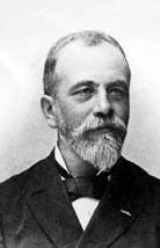
Marcel Alexandre Bertrand
Encyclopedia
Marcel Alexandre Bertrand (July 2, 1847 – February 13, 1907) was a French geologist
who was born in Paris
. He was a student at the École Polytechnique
, and beginning in 1869 he attended the Ecole des Mines de Paris. Beginning in 1877 he performed geological mapping studies of Provence
, Jura Mountains
and the Alps
. In 1886 he became an instructor at the École Nationale Supérieure des Mines
, and in 1896 was appointed a member of the Académie des sciences. He was the son of mathematician
Joseph Louis François Bertrand
(1822–1900).
Bertrand was a founder of modern tectonics
. He is remembered for the orogenic
"wave theory" of mountain-building and his introduction of the nappe
hypothesis (nappe de charriage). His wave theory described a build-up of massive folds of earth taking place over successive geological eras, called the Caledonian
, Hercynian and Alpine
periods of orogeny. Later he added a fourth event called the Huronian orogeny, which took place in Precambrian
time.
Geologist
A geologist is a scientist who studies the solid and liquid matter that constitutes the Earth as well as the processes and history that has shaped it. Geologists usually engage in studying geology. Geologists, studying more of an applied science than a theoretical one, must approach Geology using...
who was born in Paris
Paris
Paris is the capital and largest city in France, situated on the river Seine, in northern France, at the heart of the Île-de-France region...
. He was a student at the École Polytechnique
École Polytechnique
The École Polytechnique is a state-run institution of higher education and research in Palaiseau, Essonne, France, near Paris. Polytechnique is renowned for its four year undergraduate/graduate Master's program...
, and beginning in 1869 he attended the Ecole des Mines de Paris. Beginning in 1877 he performed geological mapping studies of Provence
Provence
Provence ; Provençal: Provença in classical norm or Prouvènço in Mistralian norm) is a region of south eastern France on the Mediterranean adjacent to Italy. It is part of the administrative région of Provence-Alpes-Côte d'Azur...
, Jura Mountains
Jura mountains
The Jura Mountains are a small mountain range located north of the Alps, separating the Rhine and Rhone rivers and forming part of the watershed of each...
and the Alps
Alps
The Alps is one of the great mountain range systems of Europe, stretching from Austria and Slovenia in the east through Italy, Switzerland, Liechtenstein and Germany to France in the west....
. In 1886 he became an instructor at the École Nationale Supérieure des Mines
École nationale supérieure des mines de Paris
The École Nationale Supérieure des Mines de Paris was created in 1783 by King Louis XVI in order to train intelligent directors of mines. It is one of the most prominent French engineering schoolsThe École Nationale Supérieure des Mines de Paris (also known as Mines ParisTech, École des Mines de...
, and in 1896 was appointed a member of the Académie des sciences. He was the son of mathematician
Mathematician
A mathematician is a person whose primary area of study is the field of mathematics. Mathematicians are concerned with quantity, structure, space, and change....
Joseph Louis François Bertrand
Joseph Louis François Bertrand
Joseph Louis François Bertrand was a French mathematician who worked in the fields of number theory, differential geometry, probability theory, economics and thermodynamics....
(1822–1900).
Bertrand was a founder of modern tectonics
Tectonics
Tectonics is a field of study within geology concerned generally with the structures within the lithosphere of the Earth and particularly with the forces and movements that have operated in a region to create these structures.Tectonics is concerned with the orogenies and tectonic development of...
. He is remembered for the orogenic
Orogeny
Orogeny refers to forces and events leading to a severe structural deformation of the Earth's crust due to the engagement of tectonic plates. Response to such engagement results in the formation of long tracts of highly deformed rock called orogens or orogenic belts...
"wave theory" of mountain-building and his introduction of the nappe
Nappe
In geology, a nappe is a large sheetlike body of rock that has been moved more than or 5 km from its original position. Nappes form during continental plate collisions, when folds are sheared so much that they fold back over on themselves and break apart. The resulting structure is a...
hypothesis (nappe de charriage). His wave theory described a build-up of massive folds of earth taking place over successive geological eras, called the Caledonian
Caledonian orogeny
The Caledonian orogeny is a mountain building era recorded in the northern parts of the British Isles, the Scandinavian Mountains, Svalbard, eastern Greenland and parts of north-central Europe. The Caledonian orogeny encompasses events that occurred from the Ordovician to Early Devonian, roughly...
, Hercynian and Alpine
Alpine orogeny
The Alpine orogeny is an orogenic phase in the Late Mesozoic and Tertiary that formed the mountain ranges of the Alpide belt...
periods of orogeny. Later he added a fourth event called the Huronian orogeny, which took place in Precambrian
Precambrian
The Precambrian is the name which describes the large span of time in Earth's history before the current Phanerozoic Eon, and is a Supereon divided into several eons of the geologic time scale...
time.

